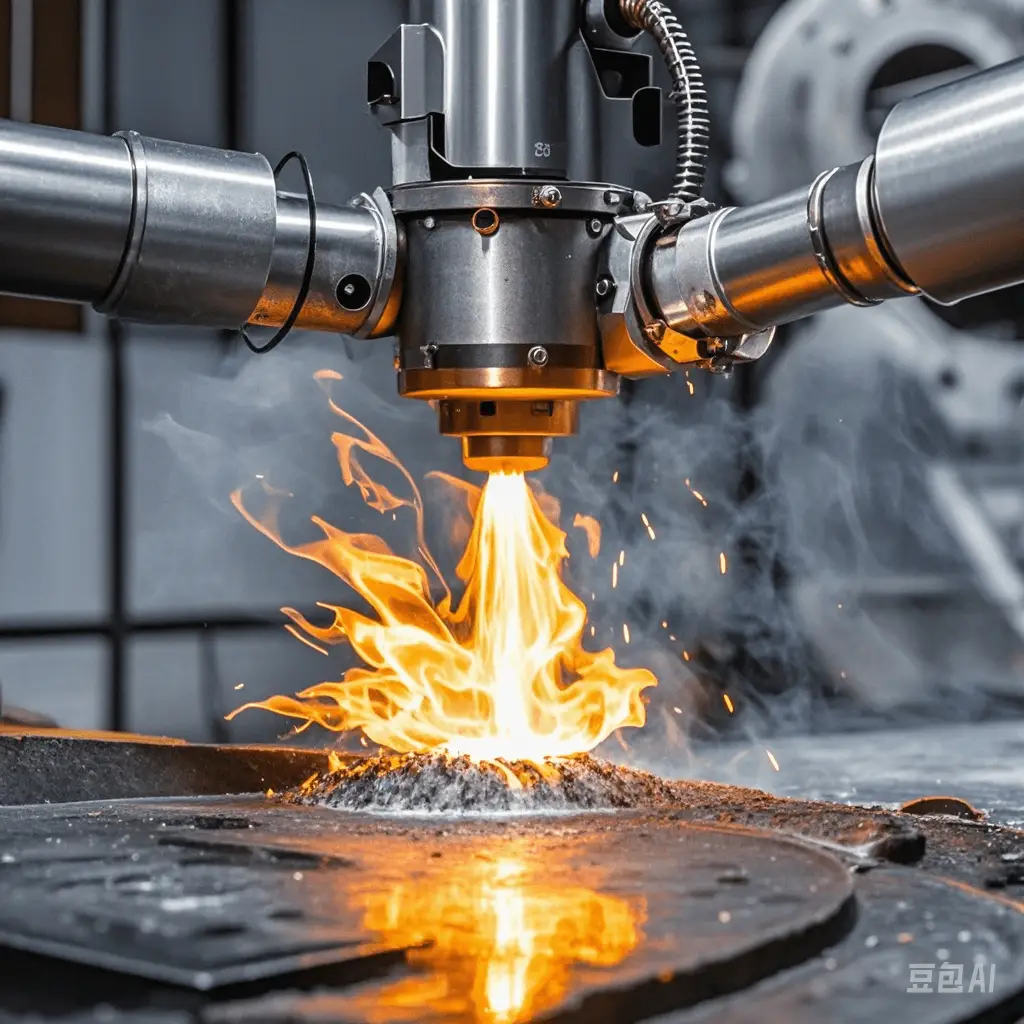Turn-key Systems



Thermal spray turnkey systems usually include all the equipment, technologies and services required for the thermal spray process. It ranges from the preliminary workpiece preparation (such as surface pretreatment equipment), the thermal spray equipment itself (spray guns, powder / wire feeding devices, etc.), to the subsequent quality inspection equipment and related technical support.
You only need to put forward your requirements for the thermal spray coating, and APT can provide a complete solution, making the whole thermal spray project as easy and smooth to implement and operate as opening a door with a key.
Such systems are highly suitable for those enterprises that hope to obtain comprehensive and convenient thermal spray services , but do not want to integrate various equipment and technologies alone.
The thermal spray turnkey system usually includes all the equipment, technologies and services required for the thermal spray process. It encompasses the following aspects:
I. Preliminary Workpiece Preparation
Surface Pretreatment Equipment
- Cleaning Equipment: It is used to remove oil, grease, dust and other contaminants from the workpiece surface. For example, organic solvent cleaning equipment can effectively remove grease contaminants, while high-pressure water gun cleaning equipment can wash away dust and loose impurities adhering to the workpiece surface.
- Sandblasting Equipment: It cleans the oxide layer, old coatings and other surface defects on the workpiece surface by high-speed spraying of abrasives (such as corundum sand, quartz sand, etc.). At the same time, it can also increase the roughness of the workpiece surface to enhance the adhesion of the coating to the substrate. The parameters of the sandblasting equipment, such as sandblasting pressure, sandblasting angle and abrasive particle size, can be adjusted according to the material of the workpiece and the specific requirements of the thermal spray process.
- Chemical Pretreatment Equipment: For workpieces made of some special materials, chemical pretreatment may be required. For example, for aluminum alloy workpieces, an etching equipment may be used to remove the oxide film on the surface and form a microscopic surface structure conducive to coating bonding.
II. Main Part of Thermal Spray Equipment
Spray Guns
Different types of spray guns are applicable to different thermal spray processes. For example, a flame spray gun uses the high-temperature flame generated by the mixture of combustible gas (such as acetylene, propane, etc.) and oxygen as the heat source to heat the spraying material to a molten or semi-molten state and then spray it onto the workpiece surface. A plasma spray gun generates a high-temperature plasma by ionizing gas (such as argon, nitrogen, etc.). The temperature of this plasma can reach tens of thousands of degrees Celsius, enabling high-melting-point materials (such as ceramic materials) to be sprayed smoothly.
The parameters of the spray gun (such as spraying distance, spraying angle, powder/wire feeding speed, etc.) have an important impact on the quality of the coating. The appropriate spraying distance can ensure that the spraying material can be evenly deposited on the workpiece surface, and the correct spraying angle helps to obtain a dense and well-bonded coating.
Powder/Wire Feeding Devices
- Powder Feeding Device: It is used to convey powdered spraying materials (such as metal powders, ceramic powders, etc.) to the flame or plasma area of the spray gun. The accuracy, stability and adjustable range of the powder feeding amount of the powder feeding device are key performance indicators. A high-precision powder feeding device can ensure that the powder feeding amount is uniform and stable during the long spraying process, thus ensuring the consistency of the coating thickness.
- Wire Feeding Device: When wire materials (such as some metal wires) are used as spraying materials, the wire feeding device accurately feeds the wire materials into the heating area of the spray gun. The wire feeding speed needs to match the heating power of the spray gun to ensure that the wire materials can be fully melted and form a high-quality coating.
Heat Source Generation Devices
Besides the gas supply system of the flame spray gun and the plasma generator of the plasma spray gun mentioned above, for other thermal spray processes, such as arc spraying, the heat source generation device is an arc generator. The arc generator generates an arc between two metal wires (as electrodes), melts the wires and atomizes them, and then sprays them onto the workpiece surface to form a coating. The power and stability of these heat source generation devices are directly related to the efficiency and coating quality of the thermal spray process.
III. Quality Inspection Equipment in the Later Stage
Coating Thickness Inspection Equipment
- Magnetic Thickness Gauge: It is suitable for detecting the thickness of non-ferromagnetic coatings on ferromagnetic substrates. It is based on the magnetic principle and determines the coating thickness by measuring the change in magnetic attraction between the probe and the substrate. For example, when spraying a ceramic coating on a steel substrate, a magnetic thickness gauge can be used to quickly and accurately measure the coating thickness.
Eddy Current Thickness Gauge: It is used to detect the thickness of non-conductive coatings on conductive substrates. When the probe approaches the workpiece surface, eddy currents are generated in the conductive substrate, and the change in the eddy current size caused by the change in the coating thickness can be measured to obtain the coating thickness. This equipment is often used to detect the thickness of organic coatings or ceramic coatings on aluminum alloy substrates. - Ultrasonic Thickness Gauge: It utilizes the propagation characteristics of ultrasonic waves in coatings and substrates to measure the coating thickness. The propagation speed of ultrasonic waves in different media is different. By measuring the time it takes for ultrasonic waves to be emitted from the probe, pass through the coating and substrate and return to the probe, the coating thickness can be calculated. It can be used for coating thickness detection of various material combinations, especially for the thickness measurement of multi-layer coating systems.
Coating Bonding Strength Inspection Equipment
- Tensile Testing Equipment: It is used to measure the tensile bonding strength between the coating and the substrate. The specimen with the coating is fixed to the fixture of the tensile testing device by an adhesive, and then a pulling force is applied until the coating separates from the substrate. The magnitude of the pulling force is recorded, and the bonding strength can be calculated based on the size of the specimen. This method can intuitively evaluate the bonding quality between the coating and the substrate.
- Scratch Testing Equipment: By moving a diamond indenter with a certain load on the coating surface and observing the situation of the coating peeling off from the substrate, the bonding strength of the coating can be evaluated. The scratch test can simulate the frictional force and local stress that the coating will experience in actual use, thereby judging the bonding performance of the coating under different loads.
Coating Porosity Inspection Equipment
- Metallographic Microscope: By preparing a metallographic sample of the coating cross-section and observing the microscopic structure of the coating under the metallographic microscope, the pore distribution in the coating can be seen intuitively. This method can qualitatively evaluate the porosity of the coating and analyze the shape, size and distribution pattern of the pores.
- Image Analysis Software: Combined with the coating cross-section images taken by the metallographic microscope or scanning electron microscope, the image analysis software can quantitatively analyze the porosity of the coating. The software calculates the porosity of the coating by counting the pixels of the pore part in the image and combining the known magnification and specimen size information.
- Liquid Penetration Inspection Equipment: The penetration liquid containing a coloring agent or a fluorescent agent is applied to the coating surface, allowing the penetration liquid to penetrate into the pores of the coating. Then the excess penetration liquid on the surface is removed, and a developer is applied. If there are pores in the coating, the penetration liquid will be adsorbed by the developer and displayed, and the size and distribution of the coating porosity can be judged by observing the display marks.
IV. Technical Support
Process Consulting Services
A professional technical team can provide the best thermal spray process plan according to factors such as the material of the customer’s workpiece, the usage environment and the performance requirements. For example, for workpieces used in a high-temperature corrosive environment, the technical team may recommend using ceramic coatings and explain in detail to the customer what ceramic materials to choose, what thermal spray process to adopt and how to set the specific process parameters.
Operation Training Services
Provide operation training for the customer’s operators on the thermal spray equipment, including equipment startup, shutdown, parameter adjustment and daily maintenance. The training can be conducted in the company’s training center or on the customer’s site. Through the combination of practical operation demonstrations and theoretical explanations, the operators can master the operation skills of the thermal spray equipment proficiently, ensuring the normal operation of the equipment and the stability of the coating quality.
After-sales Maintenance Services
Provide timely after-sales maintenance services, including equipment failure repair and spare part replacement. The company usually has a dedicated maintenance team and sufficient inventory of spare parts to ensure a quick response when the equipment fails, reducing the equipment downtime. At the same time, it can also provide the customer with a regular maintenance plan and maintenance suggestions for the equipment to extend the equipment’s service life.
cases
We have provided efficient thermal spraying solutions for many enterprises, helping them stand out in the highly competitive market!





